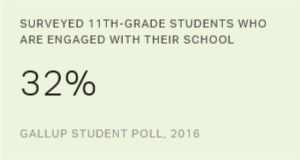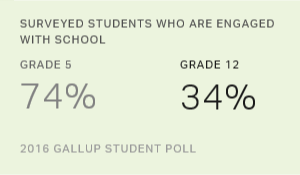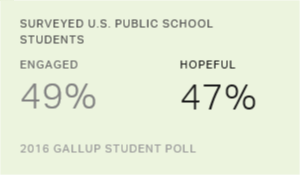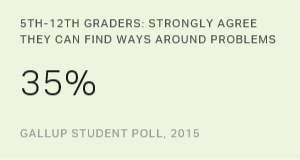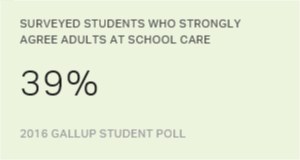This is the third article in a four-part series. Read the first, second and fourth articles.
U.S. schools face an ongoing challenge: As students get closer to high school graduation, their enthusiasm for school falls. Gallup has discovered that fifth graders are the most engaged with school, while 11th graders are the least.
These findings are from the Gallup Student Poll, which explores four elements: students' engagement with school, hope for the future, entrepreneurial aspiration and career and financial literacy.
Since the Student Poll's launch in 2009, Gallup has observed a steep school "engagement cliff" that occurs during the middle school years and continues through high school. For example, while 74% of surveyed fifth-graders are engaged with school, just 32% of surveyed 11th-graders are engaged. The latest Student Poll results are drawn from more than 3,000 schools that opted to participate in the survey in 2016.
Nine Engagement Needs
Nine items are included in the Gallup Student Poll Engagement Index. Based on their responses to the items, students are categorized as engaged, not engaged or actively disengaged. Engaged students are involved in and enthusiastic about their school.
Because there is a link between engagement and desirable student outcomes, it is important for leaders to find ways to address the school engagement cliff. Results for these nine engagement items provide clues to what underlies the waning enthusiasm that older students experience at school:
- At this school, I get to do what I do best every day.
- My teachers make me feel my schoolwork is important.
- I feel safe in this school.
- I have fun at school.
- I have a best friend at school.
- In the last seven days, someone has told me I have done good work at school.
- In the last seven days, I have learned something interesting at school.
- The adults at my school care about me.
- I have at least one teacher who makes me excited about the future.
Juniors in high school are less likely than fifth-graders to strongly agree with each of the nine engagement elements, suggesting that older students' needs are met less often at school than younger students'.
Fifth-grade students surveyed are nearly three times more likely than 11th-grade students to say that the adults at school care about them and that they have fun at school. They are about twice as likely as 11th-graders to strongly agree that they feel safe at school, they get to do what they do best every day and their teachers make them feel their schoolwork is important.
| Grade 5 | Grade 11 | ||||||||||||||||||||||||||||||||||||||||||||||||||||||||||||||||||||||||||||||||||||||||||||||||||
|---|---|---|---|---|---|---|---|---|---|---|---|---|---|---|---|---|---|---|---|---|---|---|---|---|---|---|---|---|---|---|---|---|---|---|---|---|---|---|---|---|---|---|---|---|---|---|---|---|---|---|---|---|---|---|---|---|---|---|---|---|---|---|---|---|---|---|---|---|---|---|---|---|---|---|---|---|---|---|---|---|---|---|---|---|---|---|---|---|---|---|---|---|---|---|---|---|---|---|---|
| Do best | 35 | 17 | |||||||||||||||||||||||||||||||||||||||||||||||||||||||||||||||||||||||||||||||||||||||||||||||||
| Schoolwork important | 66 | 28 | |||||||||||||||||||||||||||||||||||||||||||||||||||||||||||||||||||||||||||||||||||||||||||||||||
| Feel safe | 62 | 30 | |||||||||||||||||||||||||||||||||||||||||||||||||||||||||||||||||||||||||||||||||||||||||||||||||
| Have fun | 47 | 16 | |||||||||||||||||||||||||||||||||||||||||||||||||||||||||||||||||||||||||||||||||||||||||||||||||
| Best friend | 84 | 57 | |||||||||||||||||||||||||||||||||||||||||||||||||||||||||||||||||||||||||||||||||||||||||||||||||
| Good work | 50 | 30 | |||||||||||||||||||||||||||||||||||||||||||||||||||||||||||||||||||||||||||||||||||||||||||||||||
| Learned something interesting | 59 | 32 | |||||||||||||||||||||||||||||||||||||||||||||||||||||||||||||||||||||||||||||||||||||||||||||||||
| Adults care | 67 | 24 | |||||||||||||||||||||||||||||||||||||||||||||||||||||||||||||||||||||||||||||||||||||||||||||||||
| Excited about future | 71 | 44 | |||||||||||||||||||||||||||||||||||||||||||||||||||||||||||||||||||||||||||||||||||||||||||||||||
| Gallup Student Poll, 2016 | |||||||||||||||||||||||||||||||||||||||||||||||||||||||||||||||||||||||||||||||||||||||||||||||||||
These particular findings are from the 2016 Gallup Student Poll Snapshot Report and reflect results from the eighth annual Gallup Student Poll, a survey of students in grades 5 through 12, which provides insights into how students experience their lives in and out of school. Gallup conducted the survey via web Sept. 26-Oct. 28, 2016, and included more than 3,000 public and private schools in the U.S. and Canada that opted to participate. Nearly 5 million surveys have been completed by students from thousands of schools that opted to participate in the survey since the pilot was launched in 2009.
Six Ways to Keep Kids Excited About School
Recently, there have been gains in the U.S. high school graduation rate. Still, more can be done to help students feel involved and enthusiastic at school. Here are six ideas to address the school engagement cliff:
-
Create hope. Hope is rooted in the ideas and energy that students have for the future. Hope expert Shane Lopez once said hopeful students envision a future that is better than the present and believe they have the power to make that future a reality.
Gallup Student Poll results show that hopeful students are more likely to say they get excellent grades at school and are over four times more likely than their least hopeful peers to be engaged with school. A great way to help build students' engagement with school is to find ways to help them build a positive relationship with their future and give them chances to test-drive that future today. Students have better days at school when caring adults encourage them in their quest for clarity about the future.
- Foster talent. When my daughter, Ella, was a kindergartner, a paraprofessional wrote her a kind note at the end of the school year, thanking her for helping to love and support her friend with special needs. That paraprofessional encouraged my daughter's passion for developing others at a very young age. It was meaningful to have another adult at school recognize the strengths that I as a parent get to build each day.
Ella is now a middle-schooler and dreams of becoming a special education teacher. It is important to identify what students do best and what they enjoy doing. A little personalized recognition, coupled with opportunities to identify and develop their strengths, can have big long-term school engagement returns for students. -
Care a lot. Teachers work hard to learn the names of students each school year, but it might be just as important for students to be able to name at least one adult at school who cares about them. While two-thirds of fifth graders surveyed in 2016 strongly agree that adults at school care about them, only about one in four high school students say the same. Each student needs someone who is their cheerleader. Many student-facing adults at school can fill this important role.
-
Recognize creative teachers and teaching. Recently, I was privileged to honor teachers who had reached tremendous tenure milestones in our district. This kind of recognition is special, but insufficient. It is important to recognize teachers who boost engagement and help address the school engagement cliff by designing and implementing lessons that boost students' ability to learn difficult material, while leveraging their talents, skills and interests to get work done.
Gallup Student Poll results show that older students are less likely than younger students to strongly agree that their teachers make them feel their schoolwork is important. Leaders should take every chance to recognize teachers who help students feel that the content they are learning and projects they are completing are relevant. This could help blunt the effects of boredom and increase students' desire to expend discretionary effort that can help facilitate their readiness for the future.
-
Have fun. Last year, I snapped a picture of a group of high school students standing outside the school doors, waiting anxiously to get into a Friday night dance. It was fun to see how excited they were to get inside the building. I wondered what could be done to help students feel just as excited to come to school on random Tuesday mornings. Finding ways to make school days more fun can increase students' positive emotions, and those good feelings can serve as a platform for building engagement that leads to learning growth.
-
Model engagement. Teachers and school leaders have the unique opportunity to model engagement. Engaged staff members show students every day what it is like to live, learn and work together.
Gallup research suggests there is a link between teacher engagement and student engagement.
One way to help battle the school engagement cliff is to prioritize and model teacher and staff engagement. Teachers' excitement and enthusiasm for learning, their support and care for one another, and their strong commitment to excellence will inspire students to commit to becoming their best selves at school each day.
The next article in this series explains how identifying and developing strengths can lead to positive outcomes for students.
Does your school know the best ways to measure and build engagement among students, staff and parents? Gallup can help you find out.
Survey Methods
The Gallup Student Poll results and findings are based on surveys collected via web from 909,617 students in grades five through 12, representing about 3,000 schools from 540 school districts across 49 states and the District of Columbia. Massachusetts was the only U.S. state not included in the poll. The online poll was completed by a convenience sample of schools and districts from Sept. 26-Oct. 28, 2016. Gallup does not randomly select schools participating in the annual Gallup Student Poll, nor does Gallup charge or provide any incentives for participation beyond school-specific data. Participation rates vary by school. The survey is anonymous, and only group data are reported.
Gallup Student Poll data are not statistically weighted to account for nonresponse bias; therefore, the overall data from the annual administration of the Gallup Student Poll may not be generalizable to the U.S. student population of fifth- through 12th-grade students.
Learn more about the methodology of the Gallup Student Poll.
Portions of this blog are adapted from Shane J. Lopez's Making Hope Happen.
Gallup's Mark Reckmeyer, Sr. Consultant, and Daniela Yu, Ph.D., Sr. Researcher, Predictive Analytics, provided database management and analytics support for this article.
